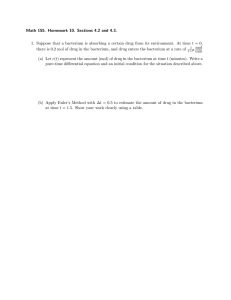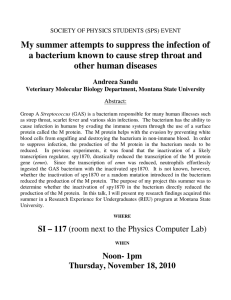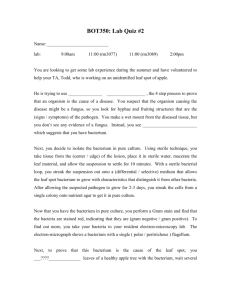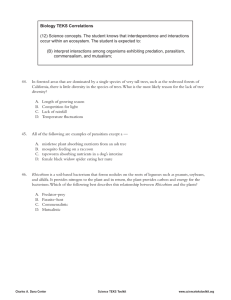vii ii iii
advertisement
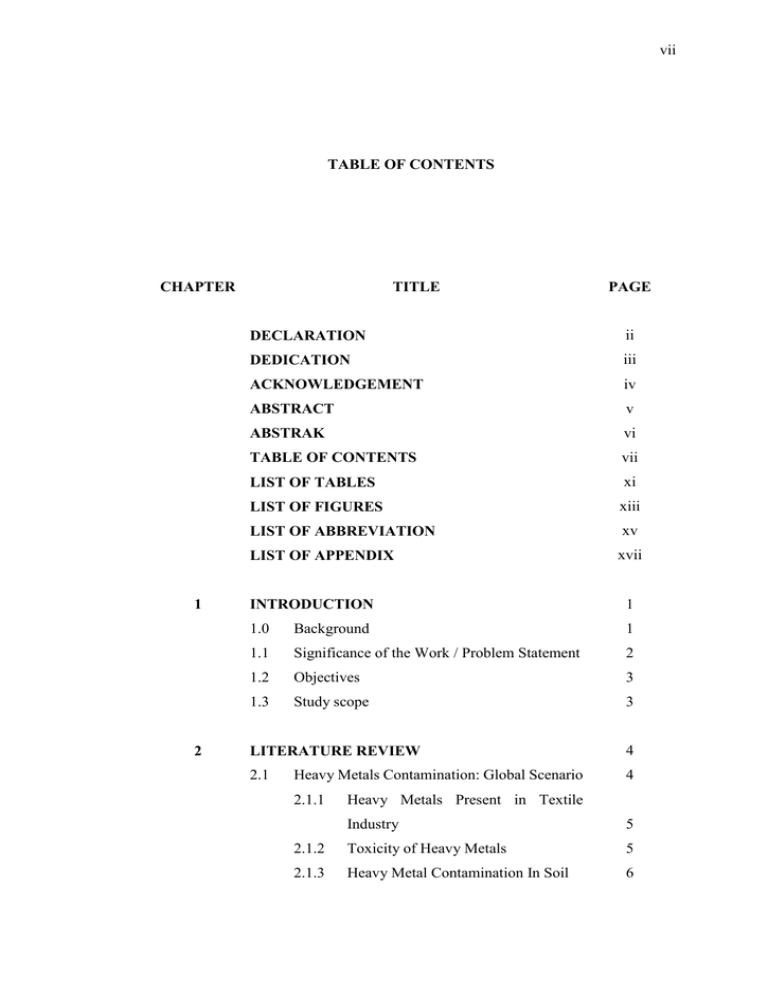
vii TABLE OF CONTENTS CHAPTER 1 2 TITLE PAGE DECLARATION ii DEDICATION iii ACKNOWLEDGEMENT iv ABSTRACT v ABSTRAK vi TABLE OF CONTENTS vii LIST OF TABLES xi LIST OF FIGURES xiii LIST OF ABBREVIATION xv LIST OF APPENDIX xvii INTRODUCTION 1 1.0 Background 1 1.1 Significance of the Work / Problem Statement 2 1.2 Objectives 3 1.3 Study scope 3 LITERATURE REVIEW 4 2.1 4 Heavy Metals Contamination: Global Scenario 2.1.1 Heavy Metals Present in Textile Industry 5 2.1.2 Toxicity of Heavy Metals 5 2.1.3 Heavy Metal Contamination In Soil 6 viii 2.1.4 Contamination of Heavy Metals at Aquatic Environment 7 2.2 Organic Compound Contamination 2.3 Sources of Heavy Metals 9 and Organic Contaminants 2.4 11 Methods Involved In Removal of Heavy Metals and Organic Compounds 14 2.4.1 Physical Treatments 14 2.4.1.1 Activated Carbon Adsorption 14 2.4.1.2 Membrane Filtration 15 2.4.2 Chemical Treatments 16 2.4.2.1 Chemical Precipitation 16 2.4.2.2 Ion Exchange 17 2.4.2.3 Chemical Advanced Oxidation 2.4.3 Biological Treatments 18 2.4.3.1 Phytoremediation 19 2.4.3.2 Biosorption 20 2.5 Biosorption of Heavy Metals Using Bacteria 21 2.6 Heavy Metal Tolerant Bacteria 22 2.7 The Applications of Heavy Metal Tolerant and Organic Compounds Degrading Bacteria 3 17 23 MATERIALS AND METHODS 24 3.1 Design Of Work 24 3.2 Medium Preparation 26 3.2.1 Nutrient Broth 26 3.2.2 Nutrient Agar 26 3.2.3 Chemically Defined Medium 26 3.2.4 Heavy Metal Stock Solution Preparation 27 3.2.5 Bacterial Culture Preparation 28 3.2.6 Antimicrobial Reagent Preparation 28 3.3 Growth Profile 28 ix 3.4 Heavy Metals Tolerance Test 29 3.5 Carbon Utilization Experiment 29 3.6 16S Full Sequence PCR Identification 29 3.6.1 Genomic DNA Extraction 29 3.6.2 Gel Electrophoresis 31 3.6.3 Polymerase Chain Reaction 31 3.6.4 PCR Product Clean Up 32 3.6.5 The 16S rRNA Gene Sequencing Analysis 3.7 4 32 Antimicrobial Reagent Test 33 RESULTS AND DISCUSSION 34 4.1 Growth Profiling 34 4.2 Heavy Metal Tolerance Test 36 4.2.1 Effect of Cobalt Sulfate (CoSO4.7H2O) on the Growth of CA Strain 4.2.2 36 Effect of Zinc Sulfate (ZnSO4.7H2O) on the Growth of CA Strain 4.2.3 38 Effect of Aluminium Potassium Sulfate (AlK (SO4).12H2O) on the Growth of CA Strain 4.2.4 Effect 40 of Manganese Chloride (MnCl2.4H2O) on the Growth of CA Strain 4.2.5 Effect of Copper Sulfate (CuSO4.5H2O) on the Growth of CA Strain 4.3 42 45 Effect of Carbon Source on the Growth of Bacterium CA 4.3.1 47 Proteinaceous Compounds as Carbon and Nitrogen Source 52 4.4 Antimicrobial Reagent Test 53 4.5 The 16S rRNA Analysis 56 4.5.1 56 Genomic DNA Extraction x 5 4.5.2 PCR 57 4.5.3 Analyse of Sequences 58 CONCLUSION AND RECOMMENDATIONS 61 5.1 Conclusion 61 5.2 Recommendations 63 REFERENCES 64 Appendices A-C 74-80 xi LIST OF TABLES TABLE NO TITLE PAGE 2.1 Source of heavy metals 11 2.2 Source of organic pollutants 13 3.2 Composition of chemically defined medium 27 4.1 The growth of bacterium CA in CDM with different organic compounds used as carbon source and casamino acids as carbon and nitrogen source. 48 xii LIST OF FIGURES FIGURE NO 3.1 TITLE PAGE Description of the steps carried out throughout the work 4.1 25 Growth pattern of bacterium CA in nutrient broth for ten hours at 37ºC 4.2 Growth of bacterium 35 CA under different concentrations of cobalt sulfate, at 37ºC 4.3 36 The specific growth rate of bacterium CA at 0 mg/L, 20 mg/L, 40 mg/L and 60 mg/L of cobalt sulfate 4.4 Growth 37 of bacterium CA under different concentrations of zinc sulfate, at 37ºC 4.5 38 The specific growth rate of bacterium CA at 0 mg/L, 40 mg/L, 60 mg/L, 80 mg/L and 100 mg/L of zinc sulfate 4.6 Growth of 39 bacterium CA under different concentrations of aluminium potassium sulfate 40 xiii 4.7 The specific growth rate of bacterium CA at 0 mg/L, 100 mg/L, 200 mg/L, 300 mg/L and 400 mg/L of aluminium potassium sulfate 4.8 Growth of bacterium CA under 41 different concentrations of manganese chloride 4.9 43 The specific growth rate of bacterium CA under 0 mg/L, 80 mg/L, 100 mg/L, 200 mg/L, 300 mg/L and 400 mg/L of manganese chloride 4.10 Growth of bacterium CA under 43 different concentrations of copper sulfate 4.11 465 The specific growth rate of bacterium CA under 0 mg/L, 60 mg/L, 80 mg/L, 100 mg/L, 200 mg/L and 300 mg/L of copper sulfate 4.12 45 The minimal inhibitory concentration (MIC) of cobalt sulfate, zinc sulfate, aluminium potassium sulfate, manganese chloride and copper sulfate on the growth of bacterium CA 4.13 47 Growth of bacterium CA at CDM provided with different organic compounds as sole carbon sources 4.14 The specific growth rate values of bacterium CA on casamino acids, glucose and glycerol 4.15 49 50 Growth of bacterium CA at CDM with casamino acids as carbon and/or nitrogen sources 52 xiv 4.16 Antimicrobial agents’ effect on bacterium CA at 37ºC, 20 hours incubation 4.17 Clear zone prevention of growth of bacterium CA formed by tetracycline hydrochloride 4.18 55 Extracted DNA band and 1kb ladder on agarose gel 4.20 54 Clear zone prevention of growth of bacterium CA formed by Kanamycin sulfate 4.19 54 57 Bands of 1kb DNA ladder and PCR product on the agarose gel 58 4.21 Blastn sheet result of bacterium CA 61 4.22 Phylogenetic tree of bacterium CA done as Neighbour-joining bootstrap method 60 xv LIST OF ABBREVIATIONS AH - Aliphatic Hydrocarbon Bacterium CA - An isolated bacterium from textile waste water Cd - Cadmium CDM - Chemically Defined Media CO2 - Carbon dioxide Cr - Chromium Cu - Copper DDTs - Dichloro Diphenyl Trichloroethanes DNA - Deoxyribonucleic acid EDTA - Ethylenediaminetetraacetic acid EMP - Embden–Meyerhof–Parnas EOC - Emerging Organic Contaminant GAC - Granular Activated Carbon HBC - Hexachlorobenzene Hg - Mercury HMP - Hexose monophosphate k - Specific growth rate MCL - Maximum Contaminant Level MEGA - Molecular Evolutionary Genetics Analysis MIC - Minimal inhibitory concentration BLASTn - nucleotide Basic Local Alignment Search Tool NCBI - National Center for Biotechnology Information OD - Optical Density PAC - Powder Activated Carbon PAH - Polycyclic Aromatic Hydrocarbon Pb - Lead xvi PCB - Polychlorinated Biphenyl PCR - Polymerase Chain Reaction rRNA - Ribosomal Ribonucleic acid STP - Sewage Treatment Plant TAE - Tris-acetate-EDTA td - Doubling time (Generation time) USEPA - United States Environmental Protection Agency UV - Ultraviolet WHO - World Health Organization Zn - Zinc xvii LIST OF APPENDICES APPENDIX TITLE PAGE A Single colony of bacterium CA 74 B Data gained from OD 600nm 75 C Partial sequence of 16S rRNA of bacterium CA 80
